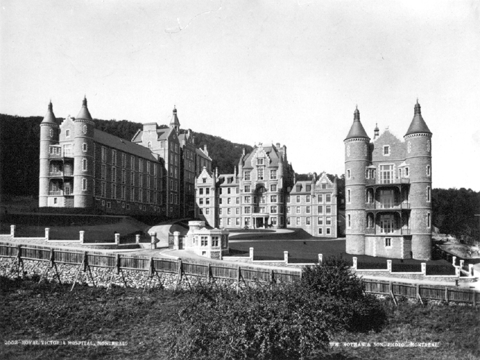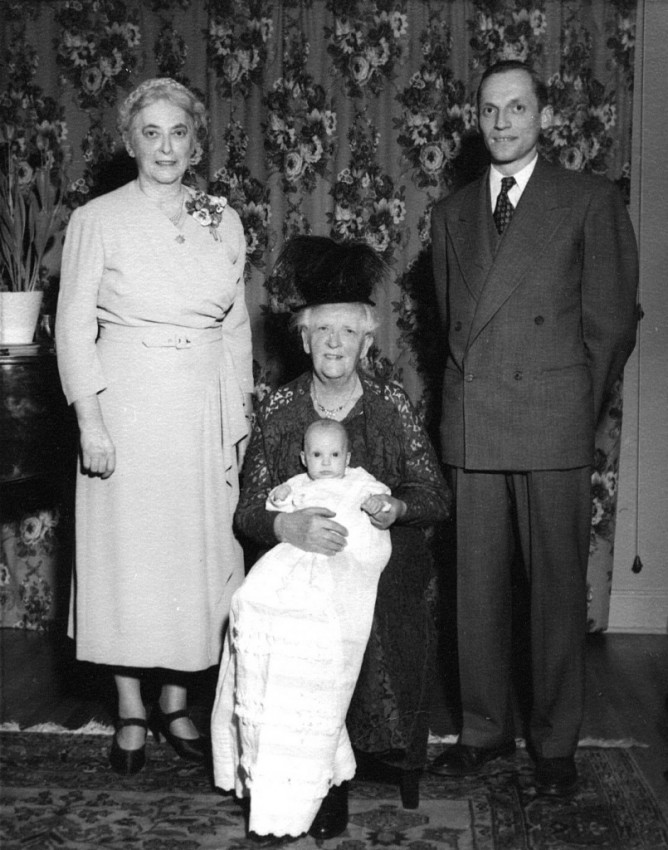Listen:
‘Reality Check’ read by the author is also available to download from the Podcast page and Tell Me A Story page
1904, Montreal, Canada
A little boy walks down the streets of Montreal with his father. The child’s name is Eric and he is 8 years old. His father, Thomas holds onto his hand tightly saying little to him along the way, but Eric will remember this walk for the rest of his life. He will later relate the story to his son, Bruce who will, in his turn pass it down to his children who relate it to me. This memorable trip takes them longer than it normally would have, as Thomas walks very slowly, pausing often. When they reach their destination, they stop in front of the Royal Victoria Hospital.
Thomas takes his young son’s hand and says to him “Eric, I am going to go inside. I want you to wait out here. When I get to where I am going, I will come to the balcony and wave. Then you can go home.” The little boy nods gravely. Time passes and his eyes keep scanning the building above him. Finally Eric sees the figure of Thomas on a balcony**, waving down at his son. Eric waves back and turns to go.
That was to be the last time he would see his father. Thomas never came home from the hospital, where he died shortly after being admitted.

Now Step Back Ten Years earlier to 1893
We have a young Victorian family setting sail for a bright new future in a distant land. The Father, aged 32 was that same Thomas in the story above. The Mother, Harriet was kept busy on the voyage caring for their three young children. Together they were leaving the comfort and security of their home on the island of Jersey, in the English Channel and travelling across the sea to a land they had never seen. Harriet was probably pregnant and the baby, Olive* (shown in the photograph below in her mother’s arms), was born soon after their arrival. The voyage surely would have been rough at times, in a boat packed full of hopeful immigrants like themselves who were looking for opportunity and a better life, whatever that meant for each person. This distant country to which they sailed was Canada.
Montreal turned out to be a bitterly cold place in the winter compared to the relatively temperate climate of their home back in the Channel Islands. In the summer they’d have had little respite from the sweltering heat and humidity in their cramped, upstairs brownstone apartment in Durocher Street. I hope that perhaps they might have been able to find some relief from that heat by visiting the shores of the mighty St. Lawrence River sometimes, though I don’t know for sure. Life would have been a struggle for this young family, but at least they had each other. In time six more children were born into the cramped quarters of the LeDain household, though sadly two never reached adulthood.

Then with an unexpected shock, the young family was torn apart. A short ten years after their arrival, so full of hope, Harriet and her eight surviving children were suddenly left without a husband and father. Thomas was only 42 years old when he died. The young widow found herself without any means of support for her children.
I had heard this story of the LeDain family and the death of the father from talking with Thomas’s grandson, that little boy Eric’s own son, Bruce LeDain before he died himself. When I was writing it some years later I contacted another grandchild, Joan, to see if she could fill in any more details from anything her mother, Irene might have told her. I sketched out the story I had so far but when I reached the part about Thomas’s death she interrupted me. “That’s not at all how he died!” I was shocked at her reaction, but asked her to relate the account as she had heard it from her mother.
This is the story that she told me:
Version 2:
Thomas was a hardworking man who was respected by all in the railway office where he was employed as a clerk. He was a man with a great faith in God who, before he began his work every morning, would get onto his knees in his office and say a private prayer.
One morning he had arrived at the usual time, said his prayer and begun his work. A colleague who came into his office saw him slumped at his desk. Thomas had died of a heart attack. This story was told to his granddaughter, Joan by her mother, Irene, Thomas’ daughter. This tale made a big impression on her, and she likes to think of her grandfather, a truly devout man, having said a last prayer just before his death.
The LeDain family situation after that point became critical and it made the accuracy of such tales of little importance, which possibly allowed their imaginations and wishful thinking free rein. What did matter is how the children and grandchildren were affected by the particular version of events that formed their own personal history and the way their own lives were changed by the sadness of this early death.
Continuing – the Family is Rescued:
As it happens, the time following the death is where the stories converge. His young wife Harriet was left a widow with 8 children. Without her husband it seemed that she would be unable to care for them and in despair the distraught mother had to put her little ones into an orphanage.
This would have been a terrible family tragedy had it not been for Thomas’ brother, an unmarried sea captain who heard of their loss and the hardship endured by the widow and children. He did not live in Canada and there is no information on how he got this news, but when he did he wrote at once to Harriet. He told her that he would not let his brother’s children be brought up in an orphanage. He promised to send her $75 every month so that she could have them with her and care for them. As long as she lived he kept his promise. All her life Harriet believed that her benefactor had remained single. After her death her children discovered that he had in fact married a Mexican woman and had children of his own. He had never told Harriet as he thought that if she knew, she would no longer accept his assistance in case it caused financial hardship for his own family.

With the help of that monthly cheque, Harriet brought up her children alone in that apartment on Durocher Street in Montreal. On the walls of the apartment were displayed exquisite needlepoint work, beautifully framed. These were all done by her brother-in-law, the sea captain who had given her the means to raise her family with dignity. These are cherished by the great grandchildren of Harriet and Thomas to this day just as each treasures his own story of how this man died.
No Reality Check
How is it possible for there to be two such different but detailed accounts of the death of one man, both related by a close family member? Who can now know which was true, or if either was?
Family stories give a personal perspective on history. You have confidence that they are true because you heard them directly from trusted relatives, or those close to them – they relate collected remembered experiences through the ages.
The stories were both verified by those who heard them directly from their parents who were children of Thomas. The only problem is that they are both completely different, yet each comes with details and emotions that colour the way these people and their own children have thought of their grandfather and great grandfather. The artist, Bruce cherished the mental picture he had of the grandfather he never knew, taking his last walk to the hospital with his own father, a little boy who was able to wave goodbye to him. Joan, a nurse, herself of strong faith loved the thought of her industrious and devout grandfather having made his peace with his god before his demise.
The family photograph below shows Harriet (my great grandmother), with her daughter Irene (one of the children in the family photo above) and her son Lloyd (my father). I am sitting on Harriet’s lap.

Over 100 years has passed since those events and in all that time none of the children who were building their memories and their versions and handing these down to their offspring had apparently conferred or shared these with their siblings. There had never been a reality check.
We all have our own stories from our parents and grandparents just like these. These become our history and the history of the world. It makes you think, doesn’t it?
*Olive, the baby mentioned above, became one of the Great Aunts mentioned in the story on this blog: Of Great Aunts and Moss Gardens
**The balcony from which Thomas waved still exists and can be seen at the Royal Victoria Hospital in Montreal.

Hi Ellie
I came across your blog by chance, searching for recipes ! You write so wonderfully well. Except for a pieces of jewellery or antique we might have inherited, rarely do we remember the lives of our previous generations, their struggles, hopes & what they really went through. Their lives were as real as ours are. You put everything so beautifully. Thanks for the experience.
Have you written any books? I’d like read books by you, if you have authored some.
Thank you so much for that lovely comment Sujata. I agree completely with what you say. It’s so important to really try to relate to those who lived before. No, I have not written a book. If you subscribe to my blog, then you will see my writing and if I do publish a book ever, you will know! Thanks again.
Ellie
A beautiful rendition of memory, respect and heritage, Ellie. Lovely pictures and even lovelier narrative. Bless you, my friend.
Thank you also for that lovely comment, Sandra. I am so touched to see you use words that mean so much in this context, words like respect and heritage, which I did my best to preserve and maintain. Thanks again my friend.
Ellie: I love to hear stories of people’s history. They are so rich with the traumas of life. Some years back I decided to put some of the family history together. I got distracted and did not finish. Thank you for sharing this one. Valerie
I’m like you, Valerie, they really fascinate me. We just see a rather flat black and white photo, but those were living, breathing people, our ancestors, with hopes, dreams and sadness just like us. Those stories are worth the telling. I hope you get yours out and finish them. Thanks for the comment, Valerie.
What a great story Ellie. You have such a way with words. The fact that it is true makes it even more remarkable. Thank for the enjoyment. Wonderful of you to share it with others. Linda
I’m so glad you enjoyed reading it, Linda. It was a story with a twist, interesting just in itself, but strange with that double ending. Thanks for the comment.